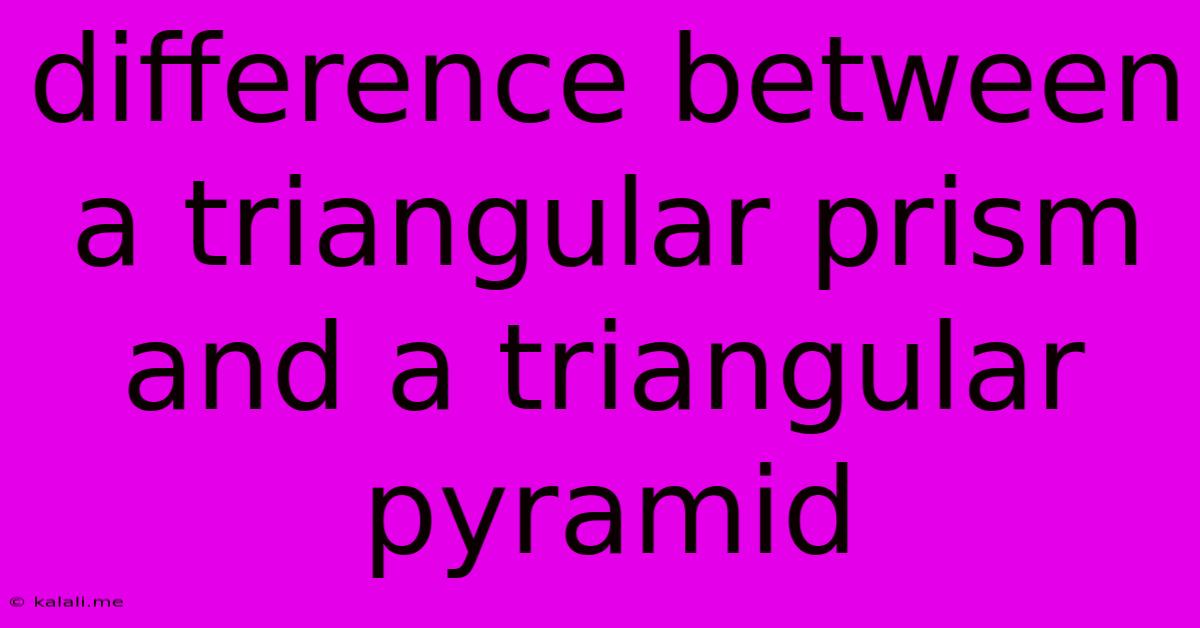Difference Between A Triangular Prism And A Triangular Pyramid
Kalali
Jun 15, 2025 · 3 min read

Table of Contents
Triangular Prism vs. Triangular Pyramid: Spotting the Differences
Understanding the difference between a triangular prism and a triangular pyramid is fundamental in geometry. While both shapes involve triangles, their distinct structures lead to different properties and applications. This article will delve into their key differences, helping you easily identify and distinguish between these 3D shapes.
What is a Triangular Prism?
A triangular prism is a three-sided prism; a polyhedron composed of two parallel triangular bases and three rectangular lateral faces connecting the bases. Imagine taking two identical triangles and connecting their corresponding vertices with rectangles. This forms a solid, three-dimensional shape. Key characteristics include:
- Two congruent triangular bases: These bases are parallel and identical in shape and size.
- Three rectangular lateral faces: These faces connect the two triangular bases.
- Five faces in total: Two triangular bases and three rectangular faces.
- Six vertices: The points where the edges meet.
- Nine edges: The line segments where the faces meet.
What is a Triangular Pyramid?
A triangular pyramid, also known as a tetrahedron (if all faces are equilateral triangles), is a three-sided pyramid. It's a polyhedron with a triangular base and three triangular lateral faces that meet at a single point, called the apex. Think of it as a three-sided pyramid with a single peak. Its defining features are:
- One triangular base: This forms the bottom of the pyramid.
- Three triangular lateral faces: These faces connect the base to the apex.
- Four faces in total: One triangular base and three triangular lateral faces.
- Four vertices: Including the apex.
- Six edges: The line segments where faces meet.
Key Differences Summarized:
| Feature | Triangular Prism | Triangular Pyramid |
|---|---|---|
| Number of Bases | Two congruent triangular bases | One triangular base |
| Lateral Faces | Three rectangular faces | Three triangular faces |
| Total Faces | Five faces | Four faces |
| Shape of Faces | Triangles and Rectangles | All Triangles |
| Volume | Generally larger (for same base) | Generally smaller (for same base) |
Visualizing the Differences:
Imagine a tent. A tent's main structure resembles a triangular prism. Now, imagine a single, sharp peak—that's more akin to a triangular pyramid. The difference boils down to the presence of two parallel bases in a prism, versus a single base and an apex in a pyramid.
Applications and Real-World Examples:
Both shapes appear in various applications:
- Triangular Prisms: They're found in architectural designs, certain types of packaging, and some crystal structures.
- Triangular Pyramids: They are seen in architecture (like the pyramids of Egypt, albeit on a much larger scale with a square base), and they also serve as a fundamental shape in geometry and structural design.
Understanding the distinctions between a triangular prism and a triangular pyramid is crucial for grasping fundamental geometrical concepts and recognizing these shapes in diverse contexts. By paying attention to the number of bases, the shapes of the lateral faces, and the overall structure, you can easily differentiate between these intriguing 3D objects.
Latest Posts
Latest Posts
-
Difference Between Percent Abundance And Relative Abundance
Jun 15, 2025
-
Which Of The Following Is An Example Of An Angiosperm
Jun 15, 2025
-
Is Milk Of Magnesia A Base Or An Acid
Jun 15, 2025
-
Which Two Of The Following Statements Are True Regarding Firewalls
Jun 15, 2025
-
Does Santa Clara University Require Sat
Jun 15, 2025
Related Post
Thank you for visiting our website which covers about Difference Between A Triangular Prism And A Triangular Pyramid . We hope the information provided has been useful to you. Feel free to contact us if you have any questions or need further assistance. See you next time and don't miss to bookmark.